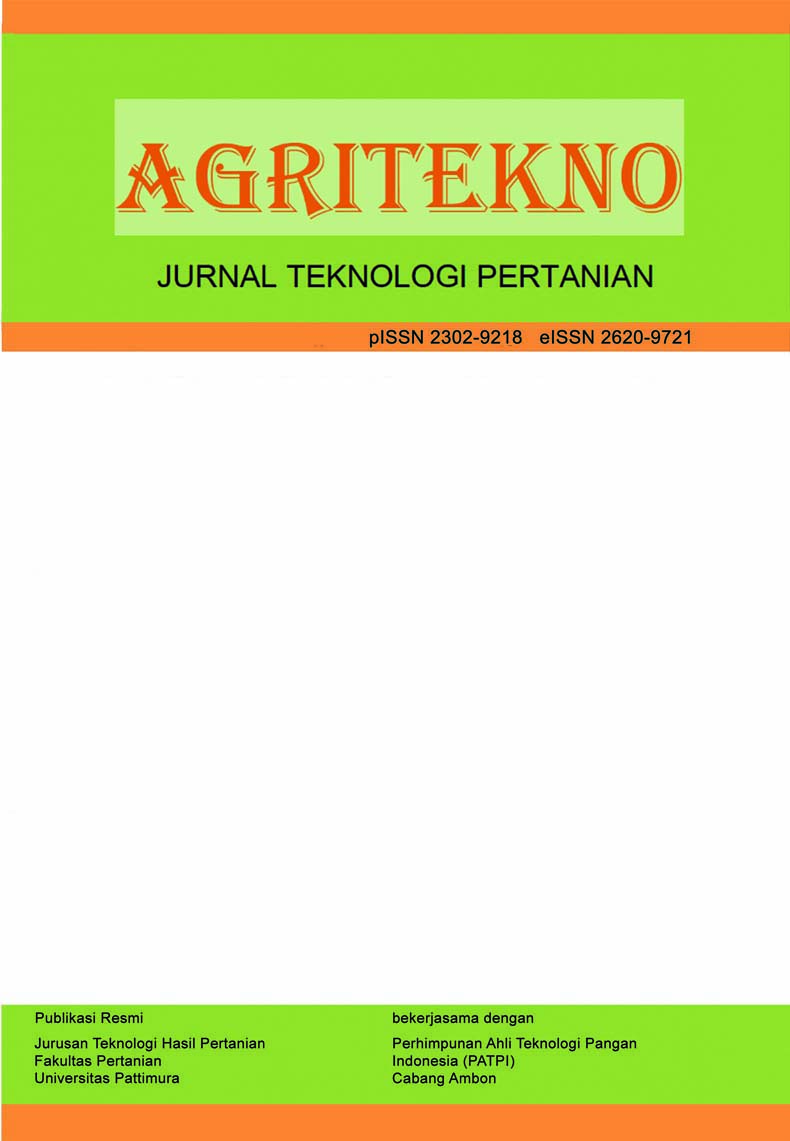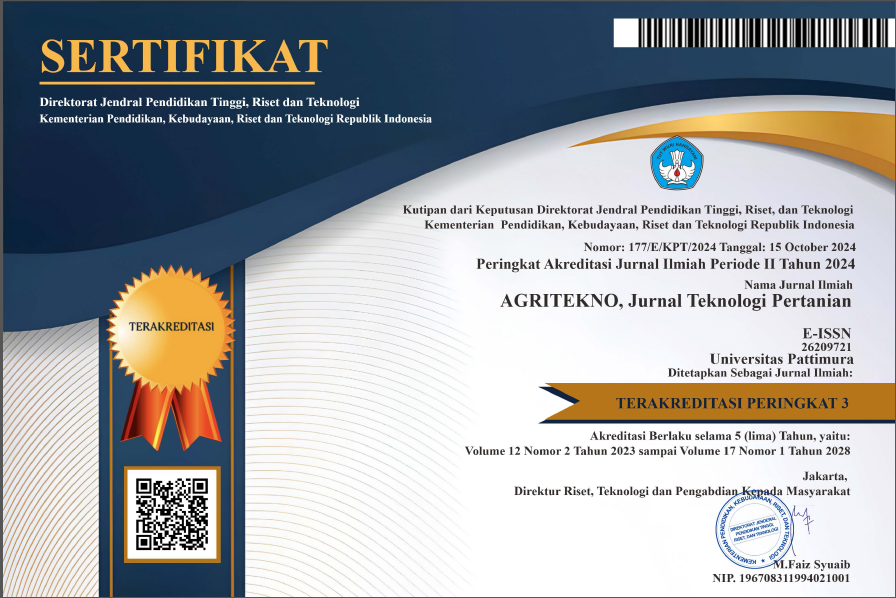Karakteristik Polisakarida Larut Air Umbi Gembili dan Umbi Dahlia serta Aplikasinya Pada Produk Pangan: Review
Water-Soluble Polysaccharides Properties of Gembili and Dahlia Tubers and Their Application in Food Products: A Review
Abstract
Local roots and tubers represent part of Indonesia’s rich biodiversity and are known for their high water-soluble polysaccharide (WSP) content. Dioscorea esculenta and Dahlia sp. tubers are notable examples that have attracted interest due to their WSP composition and potential application in a wide range of food products. However, the physicochemical properties of WSP derived from Dioscorea esculenta and Dahlia sp. tubers, as well as their applications in various food products, remain underexplored. Therefore, this review aims to provide a comprehensive understanding of the physicochemical characteristics of WSP from Dioscorea esculenta and Dahlia sp. Tubers and to highlight their potential uses in food products through a narrative literature review (NLR). The literature study indicates that the WSP present in Dioscorea esculenta tuber includes inulin and glucomannan, while Dahlia sp. tuber contains primarily inulin. WSP from both tubers exhibit unique characteristics and offer multiple functionalities, including use as thickeners, dietary fiber enhancers, prebiotics, fat and sugar replacers, texture modifiers, and emulsifiers. These attributes enable their application in a variety of food products, such as cookies, ice cream, sweet bread, chicken sausages, and kefir.
Downloads
References
Abo-Srea, M. M., Emara, E. A., & El-Sawah, T. H. (2017). Impact of konjac glucomannan on ice cream-like properties. International Journal of Dairy Science, 12(3), 177–183. https://doi.org/10.3923/ijds.2017.177.183
Afinjuomo, F., Abdella, S., Youssef, S. H., Song, Y., & Garg, S. (2021). Inulin and its application in drug delivery. Pharmaceuticals, 14, 855. https://doi.org/10.3390/ph14090855
Agustin, I. N. (2019). Pengaruh Penambahan Inulin Umbi Gembili (Dioscorea esculenta) terhadap Karakteristik Fisika dan Organoleptik pada Es Krim Rumput Laut Eucheuma cottonii. Universitas Brawijaya.
Alonso-Sande, M., Teijeiro-Osorio, D., Remuñán-López, C., & Alonso, M. J. (2009). Glucomannan, a promising polysaccharide for biopharmaceutical purposes. European Journal of Pharmaceutics and Biopharmaceutics, 72(2), 453–462. https://doi.org/10.1016/j.ejpb.2008.02.005
Astuti, I. M., & Rustanti, N. (2014). Kadar protein, gula total, total padatan, viskositas dan nilai ph es krim yang disubstitusi inulin umbi gembili (Dioscorea esculenta). Journal of Nutrition College, 3(3), 331–336.
Ayuningtyas, L. P., & Putri, D. P. (2024). Effect of varied NaCl soaking treatment on chemical composition of lesser yam flour and its use in the production of gluten-free noodles. AgriTECH, 44(2), 109–116. https://doi.org/10.22146/agritech.77976
Chua, M., Chan, K., Hocking, T. J., Williams, P. A., Perry, C. J., & Baldwin, T. C. (2012). Methodologies for the extraction and analysis of konjac glucomannan from corms of Amorphophallus konjac K. Koch. Carbohydrate Polymers, 87(3), 2202–2210. https://doi.org/10.1016/j.carbpol.2011.10.053
Ciobanu, I., Cantor, M., Stefan, R., Buta, E., Magyari, K., & Baia, M. (2016). The influence of storage conditions on the biochemical composition and morphology of dahlia tubers. Notulae Botanicae Horti Agrobotanici Cluj-Napoca, 44(2), 459–465. https://doi.org/10.15835/nbha44210436
Crespo, I., Arindra, A., Lualdi, J. T., Rimba, P. A., Putra, A. B. N., & Rahardja, R. (2020). Inulin from several tubers available in Indonesia and the growth of gut microbiota. Indonesian Journal of Life Sciences, 2(1), 16–22. https://doi.org/10.54250/ijls.v2i1.33
Dai, S., Corke, H., & Shah, N. P. (2016). Utilization of konjac glucomannan as a fat replacer in low-fat and skimmed yogurt. Journal of Dairy Science, 99(9), 7063–7074. https://doi.org/10.3168/jds.2016-11131
Dewanti, F. K., & Arintina, R. (2013). Substitusi inulin umbi gembili (Dioscorea esculenta) pada produk es krim sebagai alternatif produk makanan tinggi serat dan rendah lemak. Journal of Nutrition College, 2(4), 474–482.
Du, M., Cheng, X., Qian, L., Huo, A., Chen, J., & Sun, Y. (2023). Extraction, physicochemical properties, functional activities and applications of inulin polysaccharide: a review. Plant Foods for Human Nutrition, 78(2), 243–252. https://doi.org/10.1007/s11130-023-01066-6
Evizal, R. (2020). Review etnoagronomi perladangan pangan di Indonesia. Jurnal Agrotropika, 19(1), 1–10. https://doi.org/10.23960/ja.v19i1.4307
Faridah, A. (2016). Comperation of porang flour (Amorphophallus muelleri) purification method: Conventional maceration (gradient ethanol leaching) and ultrasonic maceration method using response surface methodology. International Journal on Advanced Science, Engineering and Information Technology, 6(2), 265–272. https://doi.org/10.18517/ijaseit.6.2.769
Fauziah, & Mas’udah, S. (2015). Explorations diversity of Dioscorea spp. varieties from Pasuruan, East Java: Inventory and characterization. Agrivita, 37(3), 193–203. https://doi.org/10.17503/Agrivita-2015-37-3-p193-203
Gómez, B., Míguez, B., Yáñez, R., & Alonso, J. L. (2017). Manufacture and properties of glucomannans and glucomannooligosaccharides derived from konjac and other sources. Journal of Agricultural and Food Chemistry, 65(10), 2019–2031. https://doi.org/10.1021/acs.jafc.6b05409
Handayani, M. N., Cakrawati, D., & Handayani, S. (2016). Effect of modified yam (Dioscorea esculenta) flour on some physicochemical and sensory properties of synbiotic yoghurt. IOP Conference Series: Materials Science and Engineering, 128, 012035. https://doi.org/10.1088/1757-899X/128/1/012035
Harijono, Estiasih, T., Sunarharum, W. B., & Rakhmita, S. (2010). Karakteristik kimia ekstrak polisakarida larut air dari umbi gembili (Dioscorea esculenta) yang ditunaskan. Jurnal Teknologi Pertanian, 11(3), 162–169.
Herlina, Darmawan, I., & Rusdianto, A. S. (2015). Penggunaan tepung glukomanan umbi gembili (Dioscorea esculenta L.) sebagai bahan tambahan makanan pada pengolahan sosis daging ayam. Jurnal Agroteknologi, 09(02), 134–144.
Herlina, H., Choiron, M., Herry Purnomo, B., & Kuswardhani. (2018). Penggunaan tepung glukomanan dari umbi gembili (Dioscorea esculenta L.) pada pembuatan es krim. Agritech, 38(4), 404–412. https://doi.org/10.22146/agritech.
Herlina, Purnomo, B. H., Fauzi, M., & Rambe, F. A. (2016). Penggunaan α-amilase dan variasi lama hidrolisis pada pembuatan tepung glukomanan dari umbi gembili. Jurnal Agroteknologi, 10(01), 73–86.
Hilman, A., Harmayani, E., & Cahyanto, M. N. (2021). The potential of gembili (Dioscorea esculenta L.) and dahlia (Dahlia spp L.) from Indonesia as prebiotic compound. IOP Conference Series: Earth and Environmental Science, 782, 032019. https://doi.org/10.1088/1755-1315/782/3/032109
Hilman, A., Harmayani, E., & Cahyanto, M. N. (2020). Inulin extraction and characterisation of fresh and chip gembili (Dioscorea esculenta) extract by ultrasound-assisted extraction. International Conference of Science, Technology, Engineering, Environmental and Ramification Researches - ICOSTEERR 2018, 47–53. https://doi.org/10.5220/0010084000470053
Hoky, I. T., Astarini, I. A., & Pharmawati, M. (2022). Keanekaragaman tanaman umbi – umbian yang berpotensi sebagai pangan alternatif di Kecamatan Rendang dan Bebandem, Kabupaten Karangasem, Bali. Simbiosis, 10(2), 122–139. https://doi.org/10.24843/jsimbiosis.2022.v10.i02.p01
Horiza, H., Azhar, M., & Efendi, J. (2017). Ekstraksi dan karakterisasi inulin dari umbi dahlia (Dahlia sp. L) segar dan disimpan. EKSAKTA: Berkala Ilmiah Bidang MIPA, 18(1), 31–39. https://doi.org/10.24036/eksakta/vol18-iss01/14
Hosang, E. Y., Bire, A., Sendow, C. B., Doga, H. L., Menge, D., & Hanggongu, C. (2015). Keragaman Sumber daya genetik tanaman di Timor Barat, Provinsi Nusa Tenggara Timur, serta strategi pengelolaannya. Prosiding Seminar Nasional Sumber Daya Genetik Pertanian, 27 Mei 2015, 317–325.
Hutubessy, J. I. B., Tima, M. T., & Murdaningsih. (2021). Studi etnobotani keragaman tanaman pangan lokal etnis lio flores. Jurnal Pertanian, 12(2), 96–104.
Indah, N., Zainal, & Ganesa, D. (2020). Comparison of freeze drying and foam mat drying effects on characteristics of inulin from gembili (Dioscorea esculenta). IOP Conference Series: Materials Science and Engineering, 885, 012046. https://doi.org/10.1088/1757-899X/885/1/012046
Iskandar, Y., Pudjiraharti, S., & Ratnaningrum, D. (2014). Kandungan inulin dari umbi Dahlia sp yang ditanam pada jenis tanah vertisal. JKTI, 16(1), 25–31.
Kapoor, D. U., Sharma, H., Maheshwari, R., Pareek, A., Gaur, M., Prajapati, B. G., Castro, G. R., Thanawuth, K., Suttiruengwong, S., & Sriamornsak, P. (2024). Konjac glucomannan: A comprehensive review of its extraction, health benefits, and pharmaceutical applications. Carbohydrate Polymers, 122266.
Kartika, K., Rahayuningsih, M., & Setyaningsih, D. (2019). Karakteristik kefir dengan penambahan puree umbi gembili. Edufortech, 4(2), 81–91. https://doi.org/10.17509/edufortech.v4i2.19372
Khabibulloh, M. J. M., Suhartatik, N., & Mustofa, A. (2024). Masa depan dan pengembangan bioetanol di Indonesia. AGRITEKNO: Jurnal Teknologi Pertanian, 13, 210–223. https://doi.org/10.30598/jagritekno.2024.13.1.210
Kim, D. H., Shin, D. M., Seo, H. G., & Han, S. G. (2019). Effects of konjac gel with vegetable powders as fat replacers in frankfurter-type sausage. Asisn-Australian Journal of Animals Sciences, 32(8), 1195–1204.
Kurt, A., & Kahyaoglu, T. (2017a). Gelation and structural characteristics of deacetylated salep glucomannan. Food Hydrocolloids, 69, 255–263. https://doi.org/10.1016/j.foodhyd.2017.02.012
Kurt, A., & Kahyaoglu, T. (2017b). The physicochemical and structural characteristics of cultivated sahlep. International Journal of Secondary Metabolite, 4(3), 488–498. https://doi.org/10.21448/ijsm.377370
Martono, Y., Apriliyani, S. A., Riyanto, C. A., Mutmainah, & Kusmita, L. (2019). Optimization of conventional and ultrasound assisted extraction of inulin from gembili tubers (Dioscorea esculenta L.) using response surface methodology (RSM). IOP Conference Series: Materials Science and Engineering, 509, 012154. https://doi.org/10.1088/1757-899X/509/1/012154
Melanie, H., Susilowati, A., Iskandar, Y. M., Lotulung, P. D., & Andayani, D. G. S. (2015). Characterization of Inulin from Local Red Dahlia (Dahlia sp. L) Tubers by Infrared Spectroscopy. Procedia Chemistry, 16, 78–84. https://doi.org/10.1016/j.proche.2015.12.027
Mensink, M. A., Frijlink, H. W., Van Der Voort Maarschalk, K., & Hinrichs, W. L. J. (2015). Inulin, a flexible oligosaccharide I: Review of its physicochemical characteristics. Carbohydrate Polymers, 130, 405–419. https://doi.org/10.1016/j.carbpol.2015.05.026
Mubarok, A. Z., & Winata, A. (2020). Pengaruh substitusi tepung terigu dengan tepung umbi dahlia dan konsentrasi baking powder terhadap karakteristik fisik cookies kaya serat. Jurnal Aplikasi Teknologi Pangan, 9(4), 175–180. https://doi.org/10.17728/jatp.5864
Naisali, H., Utoro, P. A. R., & Witoyo, J. E. (2023). Review keragaman dan metode pengolahan umbi-umbian lokal Nusa Tenggara Timur. Jurnal Pangan Dan Gizi, 13(2), 1–17. https://doi.org/10.26714/jpg.13.2.2023.1-17
Naisali, H., Witoyo, J. E., Utoro, P. A. R., & Permatasari, N. D. (2024). Eksplorasi singkat Laku Tobe, “Tumpeng” Singkong Tradisional dari Pulau Timor Barat, Nusa Tenggara Timur. Cannarium (Jurnal Ilmu-Ilmu Pertanian), 22(22), 48–54. https://doi.org/10.33387/cannarium.v22i2.9092
Parry, J. (2010). Konjac Glucomannan. In Alan Imeson (Ed.), Food stabilisers, thickeners, and gelling agents. Blackwell Publishing Ltd.
Prabowo, A. Y., Estiasih, T., & Purwantiningrum, I. (2014). Umbi gembili (Dioscorea esculenta L.) sebagai bahan pangan mengandung senyawa bioaktif : Kajian pustaka. Jurnal Pangan Dan Agroindustri, 2(3), 129–135.
Putri, V. D., Yanti, S., Dyna, F., Saryono, S., & Ismawati, I. (2022). The extraction and characterization of inulin from dahlia bulbs (Dahlia variabilis). AIP Conference Proceedings, 2708, 030001–1–030001–030008. https://doi.org/10.1063/5.0122564
Putri, W. D. R., Riyanto, E. I., Heliana, A., Wellang, A., & Zubaidah, E. (2021). Optimization of microwave-assisted extraction (MAE) time and material to solvent ratio of gembili (Dioscorea esculenta) water-soluble polysaccharides (WSP). Industria: Jurnal Teknologi Dan Manajemen Agroindustri, 10(1), 78–98. https://doi.org/10.21776/ub.industria.2021.010.01.9
Rahayuni, A., Hunandar, C., & Setiadi, Y. (2014). Aplikasi inulin umbi gembili (Dioscorea esculenta) pada produk roti manis untuk peningkatan kadar serat, sifat fisik dan tingkat penerimaan. Jurnal Riset Kesehatan, 3(1), 499–506.
Rahmat, D., Putri, V. G., Sumiyati, Y., Zaidan, S., Desmiaty, Y., & Nafisa, S. (2024). Crude inulin derived from dahlia tuber as nanomaterial and its characterization. International Journal of Applied Pharmaceutics, 16(Special Issue 3), 56–60. https://doi.org/10.22159/ijap.2024.v16s3.10
Saputro, P. S., & Estiasih, T. (2015). Pengaruh polisakarida larut air (PLA) dan serat pangan umbi - umbian terhadap glukosa darah: Kajian pustaka. Jurnal Pangan Dan Agroindustri, 3(2), 756–762.
Sareu, P. L., Nurhaeni, Ridhay, A., Mirzan, M., & Syamsuddin. (2021). Ekstraksi glukomanan dari umbi gembili (Dioscorea esculenta L.). KOVALEN: Jurnal Riset Kimia, 7(1), 51–58. https://doi.org/10.22487/kovalen.2021.v7.i1.12008
Sharma, S., & Wadhwa, N. (2022). Application of glucomannan. Journal of Pharmaceutical Research, 21(1), 1–5. https://doi.org/10.18579/jopcr/v21i1.glucomannan
Shoaib, M., Shehzad, A., Omar, M., Rakha, A., Raza, H., Sharif, H. R., Shakeel, A., Ansari, A., & Niazi, S. (2016). Inulin: Properties, health benefits and food applications. Carbohydrate Polymers, 147, 444–454. https://doi.org/10.1016/j.carbpol.2016.04.020
Sumarwoto. (2007). Review : Constituen of Mannan of Iles-iles (Amorphophallus muelleri Blume.). Bioteknologi, 4(1), 28–32.
Sun, Y., Xu, X., Zhang, Q., Zhang, D., Xie, X., Zhou, H., Wu, Z., Liu, R., & Pang, J. (2023). Review of konjac glucomannan structure, properties, gelation mechanism, and application in medical biology. Polymers, 15, 1852. https://doi.org/10.3390/polym15081852
Tang, Q., & Huang, G. (2022). Improving method, properties and application of polysaccharide as emulsifier. Food Chemistry, 376, 131937.
Tester, R., & Al-Ghazzewi, F. (2017). Glucomannans and nutrition. Food Hydrocolloids, 68, 246–254. https://doi.org/10.1016/j.foodhyd.2016.05.017
Tester, R. F., & Al-Ghazzewi, F. H. (2013). Mannans and health, with a special focus on glucomannans. Food Research International 50, 50, 384–391. https://doi.org/10.1016/j.foodres.2012.10.037
Tyastirin, E., Oktorina, S., & Febriyanti, I. A. (2024). Prebiotic Potential of Gembili, Dahlia and Yacon Tuber Flours. 4.
Ulissyifa, M. U. (2023). Formulasi dan Uji Karakterisasi Fisikokimia Kefir Susu Sapi Terfortifikasi Ekstrak Inulin Umbi Dahlia (Dahlia sp L). Universitas Islam Negeri Maulana Malik Ibrahim.
Utomo, S., Zakiyah Adnan, A., Sulistyo Dhamar Lestari, R., & Kartika Sari, D. (2019). Pengaruh rasio pelarut dan waktu ekstraksi terhadap kadar glukomanan pada ekstraksi umbi gembili (Discorea esculenta L) berbantu gelombang mikro. Prosiding Seminar Nasional Teknik Kimia “Kejuangan,” C3-1-C-3–7.
Wang, Z., Zhao, S., Tao, S., Hou, G., Zhao, F., Tan, S., & Meng, Q. (2023). Dioscorea spp.: bioactive compounds and potential for the treatment of inflammatory and metabolic diseases. Molecules, 28, 2878. https://doi.org/10.3390/molecules28062878
Wedamulla, N. E., & Wijesinghe, W. A. J. P. (2021). Application of polysaccharides in food technology: A review. Trends in Carbohydrate Research, 13(2), 35–49.
Widjanarko, S. B., Affandi, M., & Wahyuli, Z. (2022). A review on konjac glucomannan and hydrolysed konjac glucomannan. Food Research, 6(5), 425–433. https://doi.org/10.26656/fr.2017.6(5).920
Widjanarko, S. B., Imaduddin, A., Yunianta, Y., & Witoyo, J. E. (2023). Concentration optimization of meat, MOCAF (Modified Cassava Flour), and purified porang flour-k-Carrageenan (PPFC) mixed hydrocolloid gel for restructured sliced meat formula using response surface methodology. Trends in Sciences, 20(4), 6486. https://doi.org/10.48048/tis.2023.6486
Winarti, S., Harmayani, E., & Nurismanto, R. (2011a). Karakter dan profil inulin beberapa jenis uwi (Dioscorea spp.). Agritech, 31(4), 378–383.
Winarti, S., Harmayani, E., & Nurismanto, R. (2011b). Extraction of Inulin from various yam tubers (Dioscorea spp.). The 12th ASEAN Food Conference 2011, 669–673.
Witoyo, J. E., Argo, B. D., Yuwono, S. S., & Widjanarko, S. B. (2023). The response surface methodology approach successfully optimizes a dry milling process of porang (Amorphophallus muelleri Blume) flour production that uses micro mill-assisted by cyclone separator. Agricultural Engineering International: CIGR Journal, 25(1), 176–190.
Wouters, R. (2009). Inulin. In A. Imeson (Ed.), Food Stabilisers, Thickeners And Gelling Agents (pp. 180–197). John Wiley & Sons.
Yanuriati, Anny, Marseno, D. W., Rochmadi, & Harmayani, E. (2017). Characteristics of glucomannan isolated from fresh tuber of Porang (Amorphophallus muelleri Blume). Carbohydrate Polymers, 156, 56–63. https://doi.org/10.1016/j.carbpol.2016.08.080
Yuliana, R., Kusdiyantini, E., & Izzati, M. (2014). Potensi tepung umbi dahlia dan ekstrak inulin dahlia sebagai sumber karbon dalam produksi fruktooligosakarida (FOS) oleh Khamir Kluyveromyces marxianus DUCC-Y-003. Bioma, 16(1), 39–49.
Zhang, C., Chen, J. Da, & Yang, F. Q. (2014). Konjac glucomannan, a promising polysaccharide for OCDDS. Carbohydrate Polymers, 104, 175–181. https://doi.org/10.1016/j.carbpol.2013.12.081
Zhou, N., Zheng, S., Xie, W., Cao, G., Wang, L., & Pang, J. (2022). Konjac glucomannan: A review of structure, physicochemical properties, and wound dressing applications. Journal of Applied Polymer Science, 139, e51780. https://doi.org/10.1002/app.51780
Zhu, F. (2018). Modifications of konjac glucomannan for diverse applications. Food Chemistry, 256, 419–426. https://doi.org/10.1016/j.foodchem.2018.02.151
Zubaidah, E., & Akhadiana, W. (2013). Comparative study of inulin extracts from dahlia, yam, and gembili tubers as prebiotic. Food and Nutrition Sciences, 4(11), 8–12. https://doi.org/10.4236/fns.2013.411a002
Copyright (c) 2025 The Author(s)

This work is licensed under a Creative Commons Attribution-ShareAlike 4.0 International License.
Authors who publish with this journal agree to the following terms:
- Authors retain copyright and grant the journal the right of first publication with the work simultaneously licensed under a Creative Commons Attribution License that allows others to share the work with an acknowledgement of the work's authorship and initial publication in this journal.
- Authors are able to enter into separate, additional contractual arrangements for the non-exclusive distribution of the journal's published version of the work (e.g., post it to an institutional repository or publish it in a book), with an acknowledgement of its initial publication in this journal.
- Authors are permitted and encouraged to post their work online (e.g., in institutional repositories or on their website) prior to and during the submission process, as it can lead to productive exchanges, as well as earlier and greater citation of published work (See The Effect of Open Access).









